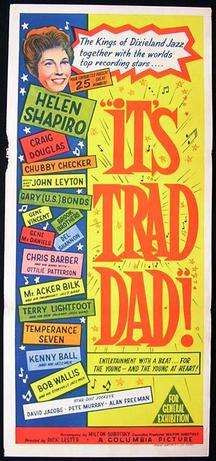It's Trad, Dad!
| It's Trad, Dad! | |
|---|---|
 Theatrical release poster | |
| Directed by | Richard Lester |
| Produced by |
Max Rosenberg Milton Subotsky |
| Written by | Milton Subotsky |
| Starring |
Helen Shapiro Craig Douglas Felix Felton Deryck Guyler |
| Music by | Ken Thorne (incidental music) |
| Cinematography | Gilbert Taylor |
| Edited by | Bill Lenny |
Production company | |
| Distributed by | Columbia Pictures |
Release date | 30 March 1962 |
Running time | 78 min. |
| Country | United Kingdom |
| Language | English |
| Budget | £50,000[2] |
| Box office | £300,000 (UK)[2] |
It's Trad, Dad! (1962), known in the U.S. as Ring-A-Ding Rhythm, is a musical comedy featuring performances by a variety of jazz bands and rock-and-roll singers. The film was one of the first put out by Amicus Productions, a company known predominantly for horror films. It was director Richard Lester's first feature film.[3]
Plot
Craig (Craig Douglas) and Helen (Helen Shapiro, then 15-years-old) are teenagers who enjoy the latest trend of traditional jazz along with their friends. The local mayor and a group of adults dislike the trend, and move to have the jukebox in the coffee shop silenced.
With the help of a character who also functions as an omniscient narrator, Craig and Helen journey to a TV studio to find a disc jockey and organize a show to gain popularity for the music. They eventually get to see Pete Murray and persuade him to attend and arrange for several jazz bands to perform. Upon hearing the news of the upcoming performance, the mayor decides to stop the performers' bus by any means necessary.
When the show is scheduled to start, Craig and Helen find that their disc-jockey and musicians have not yet arrived, so they perform themselves and are well-received by the crowd. The bands' bus manages to evade a series of obstacles set up by the local police, and they arrive and put on the show for the BBC television cameras. The film ends with everyone enjoying the music, including the mayor who has been easily persuaded to take the credit for having arranged a successful show.
Cast
- Helen Shapiro
- Craig Douglas
- John Leyton
- The Brook Brothers
- Chubby Checker
- Del Shannon
- Gary U.S. Bonds (as Gary (U.S.) Bonds)
- Gene Vincent
- Gene McDaniels
- The Paris Sisters (as Paris Sisters)
- The Dukes of Dixieland (as Dukes of Dixieland)
- Chris Barber's Jazz Band with Ottilie Patterson
- Acker Bilk and His Paramount Jazz Band
- Kenny Ball and his Jazzmen (as Kenny Ball's Jazzmen)
- Bob Wallis and his Storyville Jazzmen
- Terry Lightfoot and his New Orleans Jazz Band
- The Temperance Seven
- Sounds Incorporated (as Sounds Inc.)
- David Jacobs
- Pete Murray
- Alan Freeman
- Felix Felton as Mayor
- Arthur Mullard as Police Chief
- Deryck Guyler as Narrator
Soundtrack
The film predominantly comprises musical numbers, including performances by the principal actors Helen Shapiro and Craig Douglas themselves. However, unlike traditional "musicals" the songs have little to do with the movie plot. The other performers shown in the Cast list were popular acts from both the U.K. and U.S.
References
- ↑ Ed. Allan Bryce, Amicus: The Studio That Dripped Blood, Stray Cat Publishing, 2000 p 15
- 1 2 Alexander Walker, Hollywood, England, Stein and Day, 1974 p227
- ↑ Gelly, Dave (2014). An Unholy Row. Equinox. p. 135.